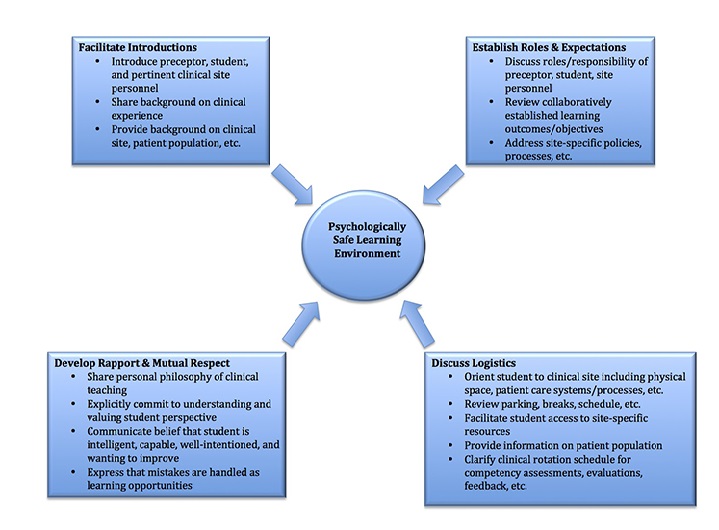Preceptor Preparation Online Course - Advanced
Mozilla Firefox preferred browser
Essential Competencies of Preceptors: A Focus on Working with APRN Students
Module 3: Clinical Teaching Strategies
Clinical Teaching Strategies
There are several strategies the preceptor can use to maximize the student's learning and help facilitate success. These include:
- Assessing the student's learning needs (discussed in Module 2)
- Establishing a psychologically safe learning environment
- Facilitating development of competence
Establishing a Psychologically Safe Learning Environment
Psychological safety is the perception that an uncertain and changing environment is safe for interpersonal risk-taking (Edmondson et al., 2014). In the context of clinical learning, it means that students perceive the learning environment to be safe to take on challenges and be held to high standards without fear of humiliation, intimidation, or belittlement (Rudolph et al., 2014). The preceptor is integral to creating a psychologically safe learning environment where questions are valued, mistakes are viewed as opportunities for learning, and high standards are held within a supportive and helpful atmosphere.
Actions the preceptor can take to establish a psychologically safe learning environment include:

Orienting the student to the clinical environment, the schedule and processes of the patient care setting, and the logistics of the clinical rotation sets the stage for all learning that follows and should occur on the first encounter. Developing rapport and mutual respect begins on the first day and continues throughout the development of the preceptor-student relationship. Ultimately, establishing and maintaining psychological safety throughout the clinical rotation is essential for a positive and engaging learning experience.
Facilitating Development of Competence

Psychomotor Competence: As the preceptor, it is important to balance the learning needs for experiences in assessment and procedural skills with the safety needs of the patient.
Balancing learning needs with patient safety can be accomplished by:
- Review the procedure with the student prior to engaging in patient care, using site-specific references and standards of best practice protocols
- Determine the student's understanding of the rationales associated with the steps of the procedure
- 'Talk/think' aloud as the procedure is being performed to facilitate the student's understanding
- Discuss the extent to which the student may require assistance and how it will be handled during the procedure
- Develop a 'safety' word or phrase that serves as a signal to the student to pull out of the procedure and allow the preceptor to take over in order to prevent harm
The preceptor should always use best judgment on whether it is safe and appropriate for a student to perform a procedure. Patient acuity, learner readiness, and available support resources are a few factors that play into the decision of how involved a learner should be in a procedure. When the preceptor deems it is appropriate for the student to perform the skill, direct observation is required.

Clinical Reasoning and Judgment Competence: Learning to think like a provider and assume the role of directing patient care can be a difficult transition for advanced practice students. It is important for the preceptor to help facilitate the student's development of clinical reasoning and judgment by:
- Using compare and contrast cases: ask how the presentation, differential diagnoses, and management may be similar and different under varying contexts (e.g., How might the management of this patient differ if it was an 84 year old female versus a 25 year old male?)
- Bridging classroom and clinical learning by asking the student to connect learning experiences in the clinical environment with what is being learned in class
- Helping the student identify and focus on what is important and notable about a patient's presentation, condition, disease process, etc.
- Encouraging the student the verbalize thought processes aloud, making independent judgments that are then clarified, reinforced, expanded up, or refined through discussion with the preceptor
- Explicitly discussing how they approach time management and organization in the diagnosis and management of patient care
Module 4 will take a deeper look into techniques that facilitate clinical decision-making of APRN students.
CHECK POINT
To answer each question select your choice, then press 'Submit'. After answering each question press the 'Forward' button on the player at the bottom right-hand corner.
This website is maintained by the University of Maryland School of Nursing (UMSON) Office of Learning Technologies. The UMSON logo and all other contents of this website are the sole property of UMSON and may not be used for any purpose without prior written consent. Links to other websites do not constitute or imply an endorsement of those sites, their content, or their products and services. Please send comments, corrections, and link improvements to [email protected].